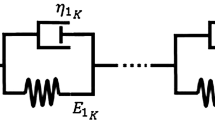Abstract
In this paper we investigate a general class of linear viscoelastic models whose creep and relaxation memory functions are expressed in Laplace domain by suitable ratios of modified Bessel functions of contiguous order. In time domain these functions are shown to be expressed by Dirichlet series (that is infinite Prony series). It follows that the corresponding creep compliance and relaxation modulus turn out to be characterized by infinite discrete spectra of retardation and relaxation time respectively. As a matter of fact, we get a class of viscoelastic models depending on a real parameter \(\nu > -1\). Such models exhibit rheological properties akin to those of a fractional Maxwell model (of order 1/2) for short times and of a standard Maxwell model for long times.








Similar content being viewed by others
Notes
For sake of completeness, it is possible to give some functional bounds for these ratios of Bessel functions, in the Laplace domain (see e.g. [7]).
References
Abramowitz M, Stegun IA (1965) Handbook of mathematical functions. Dover, New York
Buchen PW, Mainardi F (1975) Asymptotic expansions for transient viscoelastic waves. J Mec 14:597–608
Giusti A, Mainardi F (2015) A dynamic viscoelastic analogy for fluid-filled elastic tubes. Meccanica. doi:10.1007/s11012-016-0376-4
Giusti A, Mainardi F (2016) On infinite series concerning zeros of Bessel functions of the first kind. E-print. arXiv:1601.00563
Hanyga A (2001) Wave propagation in media with singular memory. Math Comput Model 34:1399–1421
Hanyga A (2005) Physically acceptable viscoelastic models. In: Hutter K, Wang Y (eds) Trends in applications of mathematics to mechanics. Shaker Verlag GmbH, Aachen, pp 125–136
Laforgia A, Natalini P. Some inequalities for modified bessel functions. J Inequal Appl 2010, Article ID 253035
Mainardi F (2010) Fractional calculus and waves in linear viscoelasticity. Imperial College Press, London
Mainardi F, Spada G (2011) Creep, relaxation and viscosity properties for basic fractional models in rheology. Eur Phys J Spec Top 193:133–160. E-print. arXiv:1110.3400
MATLAB Central, File Exchange. Bessel Function Zeros by Greg von Winckel, File ID: #6794 (Updated 27 Jan 2005)
Pipkin AC (1986) Lectures on viscoelastic theory. Springer, New York
Schilling RL, Song R (2012) Bernstein functions. Theory and applications, 2nd edn. De Gruyter, Berlin
Sneddon IN (1960) On some infinite series involving the zeros of Bessel functions of the first kind. Proc Glasg Math Assoc 4:144–156
Acknowledgments
The work of A.G. and F.M. has been carried out in the framework of the activities of the National Group of Mathematical Physics (GNFM, INdAM).
Author information
Authors and Affiliations
Corresponding author
Rights and permissions
About this article
Cite this article
Colombaro, I., Giusti, A. & Mainardi, F. A class of linear viscoelastic models based on Bessel functions. Meccanica 52, 825–832 (2017). https://doi.org/10.1007/s11012-016-0456-5
Received:
Accepted:
Published:
Issue Date:
DOI: https://doi.org/10.1007/s11012-016-0456-5




